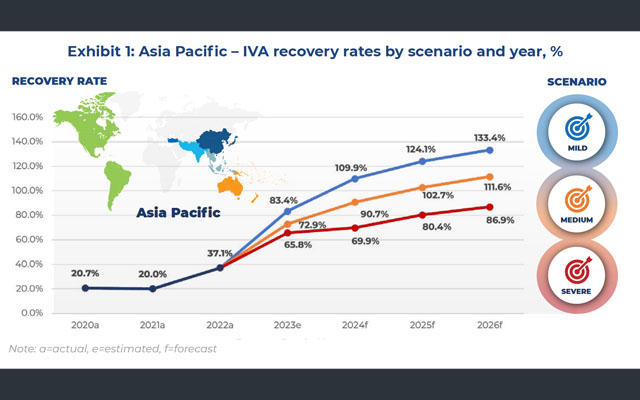
PATA’s new Asia-Pacific visitor forecast report predicts a 109.9% recovery in international visitor arrivals (IVA) by the end of this year under a benign scenario.
However, in the moderate scenario, recovery would only materialise by the end of 2025.
 PATA predicts a full recovery will not come until 2026 or later
PATA predicts a full recovery will not come until 2026 or later
As the global situation remains unstable, severe scenarios remain possible. The recovery is expected to continue more slowly until 2026, and by the end of the forecast period it is expected to remain 13 points below its 2019 level.
Across all three scenarios, growth in IVA within and across Asia Pacific is projected to be driven by Asia, the Americas, and Europe. In the medium scenario, these three source regions are projected to account for nearly 92% of all IVA generated within and across Asia Pacific in 2024, increasing slightly by 2026.
For mild and severe scenarios, these proportions are expected to differ only slightly at this aggregation level.
In tracking the performance of source markets across the Asia-Pacific region, the PATA study ranks China, the United States, Hong Kong, South Korea and Macau as the top five destinations for travelers, in descending order.
Outbound numbers from China are expected to reach the range of 109 million in 2024, with a market share of 17.7% in the top 10 source markets.
After surveying IVAs to 22 Asian destinations, PATA predicts a 107.4% recovery by the end of this year under a mild scenario and 100.4% by the end of 2025 under a moderate scenario. From a conservative perspective, a full recovery will only occur after 2026.
Within Asia, the destination sub-regions of Northeast Asia and Southeast Asia are projected to capture the majority share of IVAs in 2024, at 52.9 percent and 31.9 percent, respectively. China will account for the majority of IVAs in Asia, forecast at 105.4 million.
Announcing the prediction during a webinar on Feb. 7, Haiyan Song, associate dean of the School of Hotel and Tourism Management at the Hong Kong Polytechnic University, said that greater openness and connectivity are key to Northeast Asia’s continued recovery, while Southeast Asia will require improved domestic and interconnectivity, such as new flight routes and relaxed visa procedures.
Looking further ahead, Song said Northeast Asia could see 330 million tourists by the end of 2026, while Southeast Asia could see 157 million tourists over the same timeline, both under a moderate scenario.
PATA researchers noted that intra-Asia travel flows are projected to remain the mainstay of IVA across Asia, growing from 76% of total arrivals in 2024 to almost 79% by the end of 2026.
One of the speakers at the webinar, Caroline Bremner, head of travel research at Euromonitor International, said rail travel, festivals/leisure events and museums/cultural sites will attract the most tourism spending in 2024.
Bremner said 2024 would mark a “new era of growth” for the travel industry amid the challenges of an economic slowdown, characterised by cities thriving on the back of cultural immersive experiences, sustainable development, digital transformation and the resilience of luxury travel.

